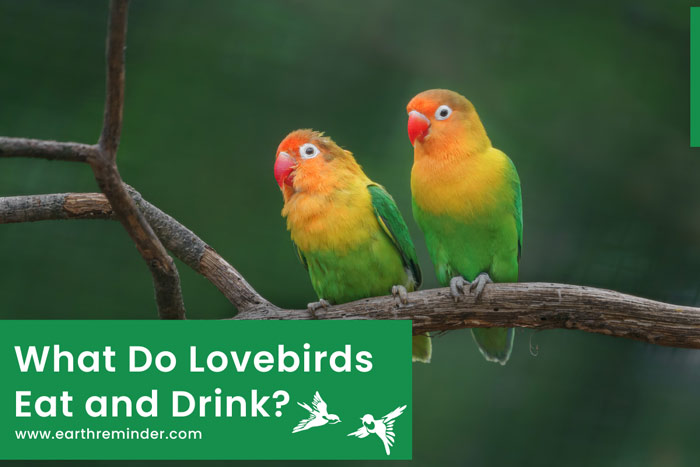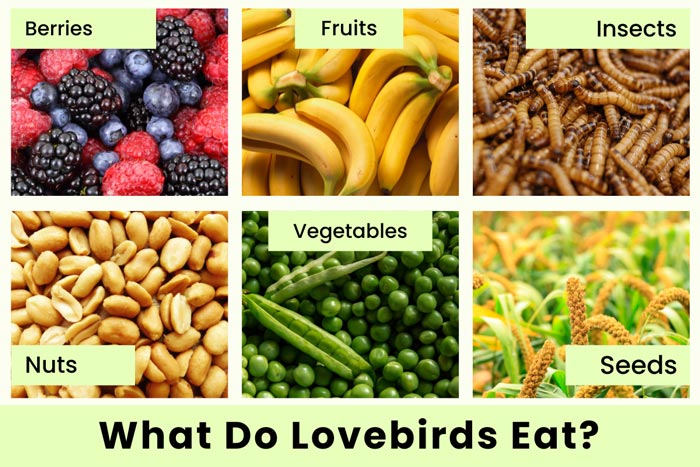Little, colorful parrots called “lovebirds” are indigenous to Africa. They are famous for being very loyal to their partners and staying committed to them. In the wild, lovebirds consume multiple kinds of food, such as fruits, seeds, and insects. Here, we will look closer at what lovebirds eat and drink in the wild.
Table of Contents
What Do Lovebirds Eat?
Lovebirds are a small group of parrots found in the wild. Since they’re mostly herbivorous in their natural habitat, plant-based foods are their main diet. Lovebirds eat fruits, vegetables, seeds, nuts, and other plant foods like buds and leaves. Some are omnivores as they eat insects. Some lovebirds are more adaptable than others and can feed on a wide range of food types, while others rely on specific foods, such as figs.
These birds can consume any available seasonal fruits and grasses in their environment and other plants food as well. When eating fruits and other foods, lovebirds display extremely social behavior and eat in large groups.
Most lovebird species can be a nuisance to farmers as they enjoy raiding fields for grains and grasses such as millet and maize, which they consume voraciously. This has caused problems in some African regions where certain lovebird species, like the Rosy-faced lovebird, have been regarded as pests.
Also Read: Why Are Birds Important to the Environment?
What Do Lovebirds Eat In The Wild?
Balanced diets not only promote good physical health, but also maintain feather quality and promote emotional well-being. Lovebirds in the wild eat the following food:
Fruits and Berries
Natural habitats give lovebirds access to a wide range of fruits and berries, which allows them to eat well-balanced diets. In the wild, they munch on fruits like figs, bananas, papayas, guavas, mangoes, and especially papayas. Their natural diet also includes berries, raspberries, and blackberries.
Lovebirds also eat the pulp and seeds of fruits, which provide them with essential nutrients such as vitamins, antioxidants, and fiber. Also, they’re flexible in their feeding habits because they eat fruits and berries based on the season.
Seeds and Nuts
Lovebirds consume various seeds, such as sunflowers, grass seeds, tree seeds, millet, canary seed, and fresh corn. They also eat nuts, such as almonds, walnuts, peanuts, and pecans. These nuts have hard shells that they crack with their strong beaks.
Vegetables
In the wild, lovebirds consume a variety of vegetables. They eat carrots, cucumbers, squash, broccoli, beets, fresh green peas, and leafy greens like spinach and kale. Lovebirds need leafy greens because they’re high in calcium, which helps them build their bones and lay eggs. They also need vegetables to get other vitamins, minerals, and fiber in their diet.
Insects and Bugs
Lovebirds also eat insects and other bugs in the wild. They eat grasshoppers, beetles, caterpillars, ants, meal-worms, and flies. But they don’t make up a huge part of the diet. Insects are an important source of protein for lovebirds, which they need to grow and develop well.
The lovebirds also form flocks so they can search for food together and stay protected from predators. Generally, the diet of lovebirds in the wild is varied and consists of fruits, seeds, vegetables, insects, and nuts. To maintain their health and welfare, imitating this diet in captivity is crucial.
Also Read: How Does Deforestation Affect Birds?
What Do Love Birds Drink?
Similar to most bird species, wild lovebirds consume water. They typically find water sources from:
- Lovebirds drink rainwater that collects on leaves, flowers, and branches after a rainstorm. It’s usually clean and safe for them to drink.
- Lovebirds can drink from rivers and streams during the dry season when other water sources are scarce.
- Lovebirds get water from their food, especially fruits and vegetables with high water content.
- Lovebirds drink from puddles of water that form after rain or in low-lying areas. It might be contaminated, so lovebirds can get sick from drinking it.
- A lovebird may drink water from a bird feeder or bowl if humans provide it.
It’s crucial to ensure lovebirds have constant access to fresh, clean water if you keep them as pets. You can get them a water dish or even a bottle connected to their cage, but make sure you change the water daily to stop bacteria formation. Moreover, please avoid some drinks and food which we will discuss below.
Also Read: How to Save Birds from Radiation and Extinction?
What Do Love Birds Not Eat?
Some types of food shouldn’t be fed to lovebirds. Foods like fast food, sugary foods, greasy or salty foods, and carbonated or caffeine-containing drinks aren’t good for lovebirds. Alcohol is also bad for lovebirds, as it can hurt their livers. Foods, like avocado, lime, and rhubarb (due to oxalate crystals), are also considered harmful to lovebirds. Healthy nutrition is important for the health and well-being of lovebirds.
Some key points that describe better what wild love birds do not eat are listed below:
Meat and Dairy Products
Lovebirds do eat insects, but they’re not adapted to digesting animal-based food, so meat and dairy products can cause problems. These foods can cause stomach issues because their digestive systems are unprepared to handle them.
Avocado
Avocado and other foods, including avocado, shouldn’t be served to lovebirds. Persin, a toxin found in avocados, is poisonous to birds and can result in respiratory distress, heart failure, and even death. If you notice your lovebird has eaten an avocado, contact your veterinarian immediately.
Also, read the ingredient label carefully before giving your lovebirds commercial bird food and treats because some may contain small amounts of avocado.
Chocolate
Chocolate is poisonous to birds as it contains a chemical called theobromine, which is toxic to them. It can cause vomiting, diarrhea, tremors, seizures, and even death in severe cases.
Chocolate isn’t a natural food source, so lovebirds won’t find it in the wild. They don’t usually eat chocolate, so don’t feed them any foods that contain it. But captive lovebirds can be exposed to chocolate, whether deliberately or accidentally. It’s best to keep all chocolate products away from them.
High-fat Foods
Wild love birds get their fat from natural foods like seeds and fruits. Captive lovebirds may not have the same variety of foods, so you’ll need to supplement their diet. A lovebird’s diet must stay clear of foods high in fat. These foods can cause obesity, liver problems, and other health problems. A high-fat diet can also cause digestion problems and vitamin deficiencies.
It’s vital to remember that since love birds might not consume such items in the wild, they shouldn’t be provided in captivity. Maintaining love birds’ general health and well-being will be easier if you give them nutritious, balanced food.
Also Read: Which Birds Cannot Fly?
Conclusion
Lovebirds tend to consume seeds, fruits, berries, and plant matter in the wild. Their diet may vary depending on where they live and the types of food available to them. Furthermore, termites, caterpillars, and beetles are just a few of the small invertebrates and insects that lovebirds are known to eat. Lovebirds should be fed a varied and balanced diet in captivity, including fresh vegetables, and seeds in moderation. Also, it’s critical to refrain from feeding them poisonous items like avocado, chocolate, and caffeine. The best way to ensure that lovebirds thrive, and live a long, healthy life, is to feed them a nutritious diet.

